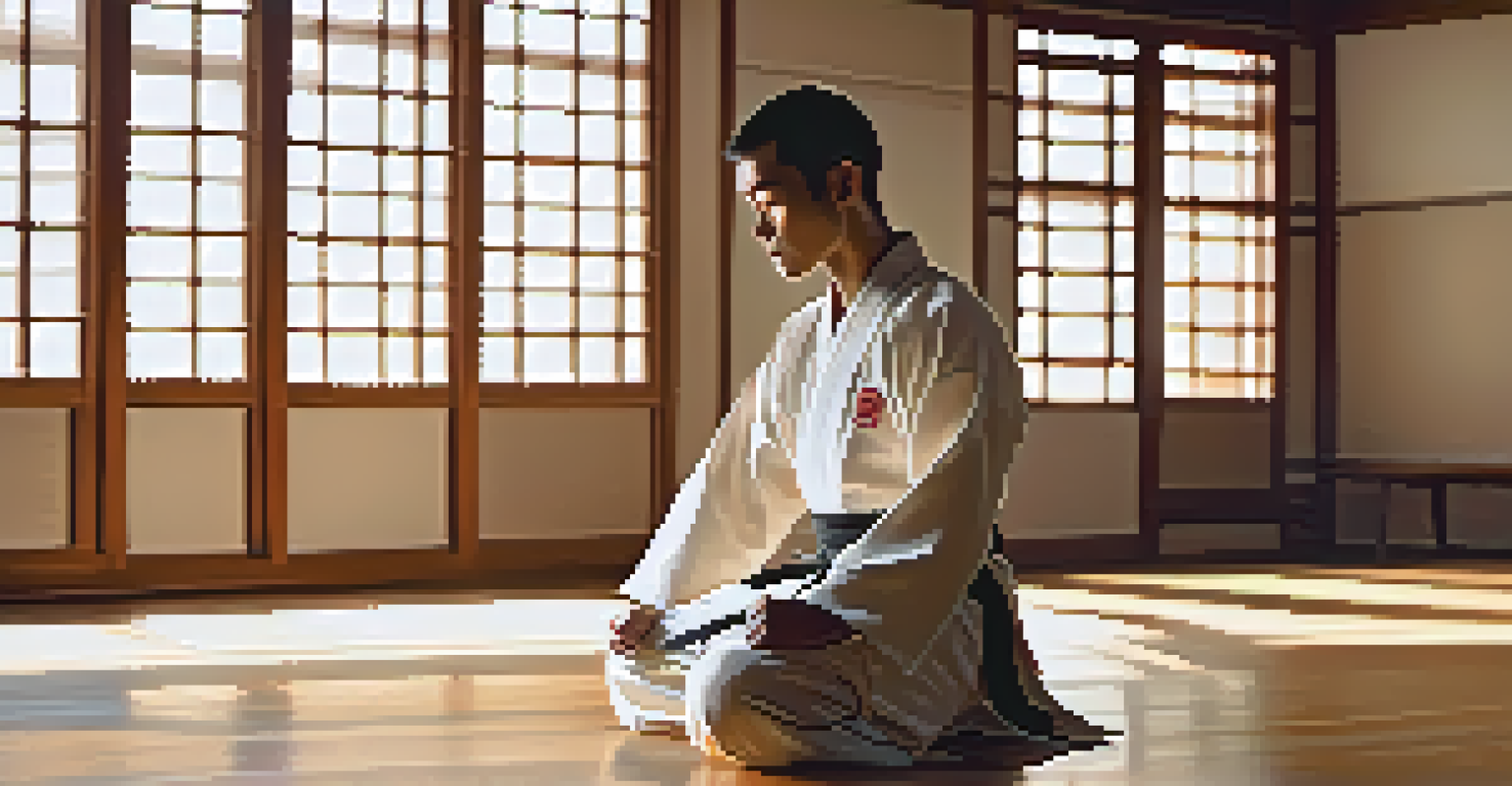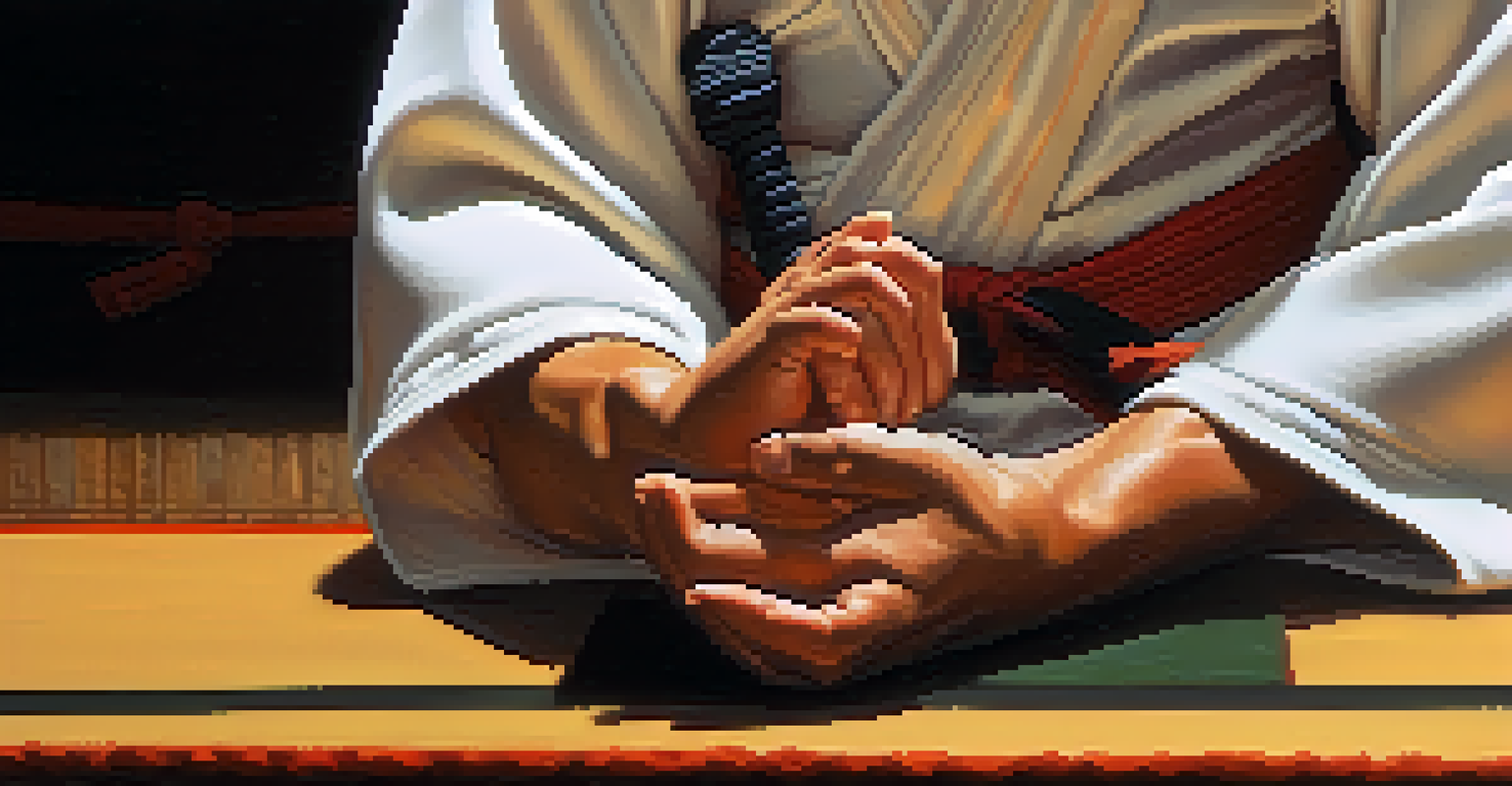The Role of Visualization in Martial Arts Training Success

Understanding Visualization in Martial Arts Training
Visualization, often referred to as mental imagery, involves creating a mental picture of movements and techniques. In martial arts, this practice can be a game changer, allowing practitioners to rehearse skills mentally. Just like a basketball player visualizes making a free throw, martial artists can envision executing a perfect kick or dodge.
Whatever you think the world is withholding from you, you are withholding from the world.
This technique isn’t just about seeing; it’s about feeling the movements and experiencing the emotions associated with them. By using all senses in their mental practice, martial artists can create a more immersive experience that leads to better retention and execution of techniques. It’s a powerful way to bridge the gap between theory and practical application.
Moreover, visualization can be tailored to individual needs, focusing on specific areas such as sparring, forms, or self-defense scenarios. By regularly incorporating this practice into their training routine, martial artists can enhance their confidence and mental preparedness, ultimately leading to improved performance in real situations.
The Science Behind Visualization Techniques
Research in sports psychology has shown that visualization can significantly enhance physical performance. When athletes visualize their movements, their brain activates the same neural pathways as when they physically perform the activity. This means that even without physical practice, mental rehearsal can help improve muscle memory and coordination.

For martial artists, this scientific backing provides a solid foundation for incorporating visualization into their training. Studies suggest that visualizing techniques can result in a 20-30% improvement in performance, making it an invaluable tool for anyone serious about their martial arts journey. Imagine training less physically while still gaining substantial benefits!
Visualization Boosts Performance
Practicing mental imagery can enhance martial artists' skills and improve muscle memory by activating the same neural pathways used during physical training.
Additionally, visualization can help reduce anxiety and increase focus during competitions. By mentally rehearsing their routines and strategies, martial artists can approach their matches with a clearer mind and a more relaxed body, setting themselves up for success on the mat or in the ring.
Practical Visualization Exercises for Martial Artists
To harness the power of visualization, martial artists can start with simple exercises. One effective method is to find a quiet space, close the eyes, and imagine performing a specific technique step-by-step. This could be a roundhouse kick or a complex kata, visualizing each movement in detail helps solidify the technique in the mind.
The mind is everything. What you think you become.
Another exercise involves using videos of high-level martial artists executing techniques. Watching these performances can help practitioners visualize themselves in similar scenarios, making it easier to replicate the movements later. This method combines observation with mental rehearsal, enhancing both understanding and execution.
Finally, pairing visualization with actual practice can amplify its effectiveness. For instance, after physically training a technique, take a moment to visualize it again while reflecting on the experience. This combination reinforces the learning process and taps into both the physical and mental aspects of martial arts training.
Overcoming Mental Barriers with Visualization
Many martial artists face mental barriers that can hinder their performance, such as fear of failure or anxiety during competitions. Visualization can serve as a powerful tool to overcome these challenges. By creating successful mental images of themselves performing under pressure, martial artists can build a more positive mindset.
When athletes visualize success, they are more likely to feel confident and prepared when it’s time to perform. This mental rehearsal helps to normalize the competition experience, reducing anxiety and boosting confidence. Think of it as a dress rehearsal before the big show, where everything feels familiar and manageable.
Consistency is Key for Success
Regularly incorporating visualization into training routines helps reinforce skills and track progress over time.
Moreover, visualization allows martial artists to rehearse not just physical techniques but also strategies for dealing with unexpected situations. By envisioning different scenarios in their mind, they can mentally prepare for various outcomes, which ultimately leads to better decision-making during actual sparring or competition.
The Role of Consistency in Visualization Practice
Just like physical training, consistency is key when it comes to visualization. Incorporating mental imagery into daily routines can significantly enhance its effectiveness. Setting aside just a few minutes each day to visualize techniques or scenarios can lead to substantial improvements over time.
Creating a visualization schedule can help martial artists establish a habit. For instance, dedicating time right after training sessions to mentally review what was learned can reinforce those skills. This consistent practice helps to maintain focus and clarity in their training goals.
Additionally, consistency allows martial artists to track their progress over time. By keeping a journal of their visualization sessions, they can note improvements, identify areas for further focus, and celebrate their successes. This reflective practice not only boosts motivation but also deepens the understanding of the role visualization plays in their overall martial arts development.
Integrating Visualization with Physical Training
Integrating visualization with physical training can create a holistic approach that enhances overall performance. For example, before starting a new technique, martial artists can visualize themselves executing it perfectly, setting a mental blueprint for their body to follow. This preparation can lead to smoother execution during the physical practice.
Moreover, visualization can be used as a warm-up exercise. Before sparring, martial artists can take a few moments to mentally rehearse their strategies and movements, ensuring they are mentally prepared for the challenge ahead. This practice can help sharpen focus and increase readiness for physical engagement.
Overcoming Mental Barriers
Visualization can help martial artists build confidence and reduce anxiety by mentally rehearsing successful performances.
Ultimately, the combination of mental and physical training creates a synergistic effect that can lead to accelerated improvement. When martial artists visualize their movements while also physically practicing them, they are more likely to achieve a higher level of mastery, making their training both efficient and effective.
Real-Life Success Stories of Visualization in Martial Arts
Many successful martial artists have shared their experiences with visualization, highlighting its impact on their training. For example, renowned fighter Georges St-Pierre often spoke about how he visualized his fights in detail, preparing for every possible scenario. This mental preparation helped him become a champion in mixed martial arts.
Similarly, Olympic athletes have utilized visualization techniques to enhance their performance. They often attribute their success not just to physical training but also to the mental edge gained through visualization. Hearing these stories can inspire others to adopt similar practices in their training.

These real-life examples serve as powerful reminders of how effective visualization can be. By learning from the experiences of others, martial artists can see the tangible benefits of incorporating mental imagery into their routines, motivating them to explore this technique further.